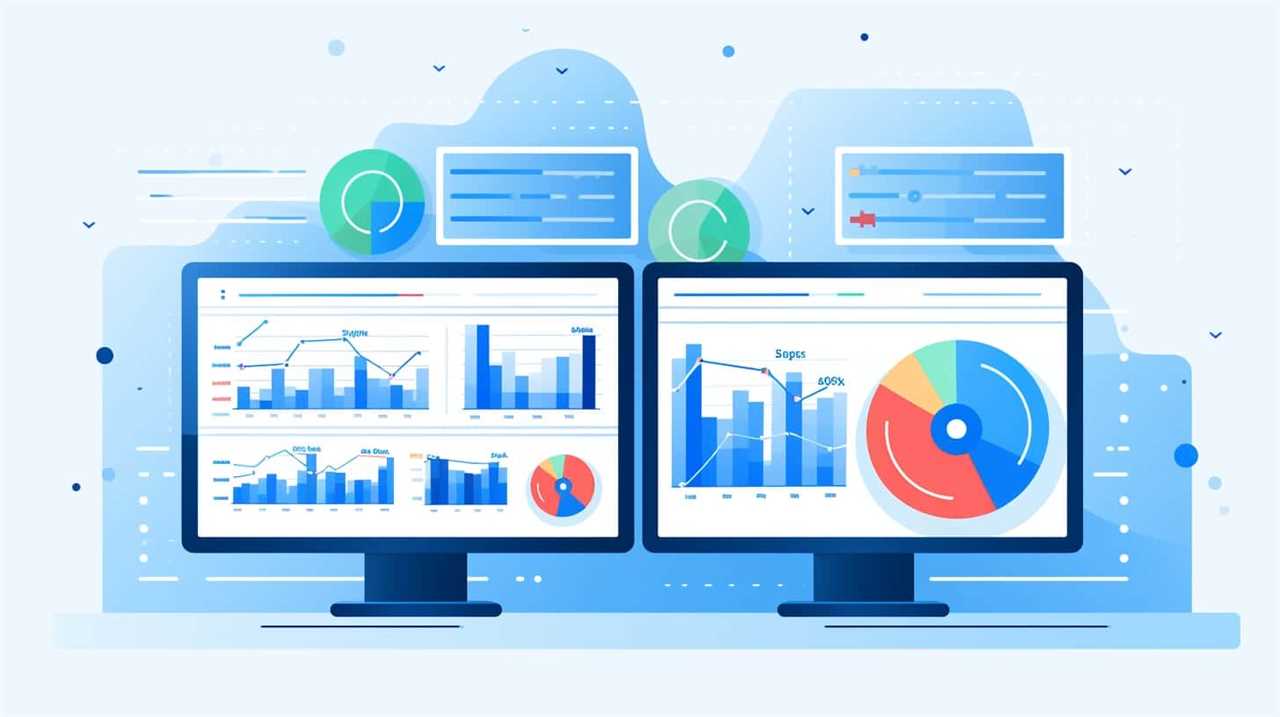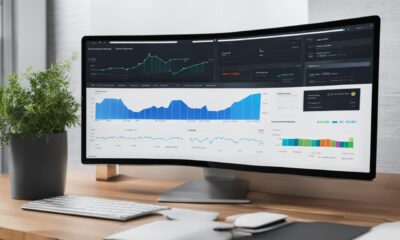Holistic SEO
SEO for Handmade Pottery Sellers: Shaping an Online Presence

Are you ready to take your handmade pottery business to the next level? We’ve got just the thing for you: SEO!
By shaping your online presence, you can attract more customers and increase your sales.
In this article, we’ll guide you through the world of SEO, from understanding the basics to staying updated with the latest trends.
Get ready to master the art of SEO and watch your pottery business flourish in the digital world.

Let’s dive in!
Key Takeaways
- Keyword research and on-page optimization are crucial for improving search engine rankings and appearing in search results.
- Creating a user-friendly navigation system and mobile-friendly design enhances the overall user experience and attracts organic traffic.
- Visual storytelling and incorporating brand personality are effective strategies for engaging and unique content creation.
- Building high-quality backlinks and utilizing social media platforms can improve search engine visibility, attract attention, and increase backlinks and visibility.
Understanding SEO Basics
To effectively optimize our online presence, we need to start by understanding the basics of SEO. As handmade pottery sellers, it’s crucial for us to grasp the importance of keyword research and on-page optimization techniques.
Keyword research plays a significant role in SEO. It involves identifying the most relevant and popular search terms that potential customers use when looking for handmade pottery. By incorporating these keywords strategically into our website content, we can increase our chances of appearing in search engine results and attracting organic traffic. It’s essential to choose keywords that accurately reflect our products and resonate with our target audience.
On-page optimization techniques refer to the process of optimizing individual web pages to improve their search engine rankings. This includes optimizing page titles, meta descriptions, headings, and URL structures. By optimizing these elements, we can make it easier for search engines to understand the content of our pages and rank them higher. Additionally, we should focus on creating high-quality, unique, and engaging content that provides value to our visitors. This won’t only improve our search engine rankings but also enhance the overall user experience.

Mastering SEO basics is vital for shaping our online presence as handmade pottery sellers. By conducting thorough keyword research and implementing effective on-page optimization techniques, we can increase our visibility, attract more potential customers, and ultimately boost our sales.
Identifying Target Keywords
When identifying target keywords for our handmade pottery business, we must focus on the most relevant and popular search terms used by potential customers. This is where keyword research and competitor analysis come into play.
Keyword research involves finding the words and phrases that people are using to search for products like ours. By understanding these keywords, we can optimize our website and content to appear in relevant search results.
To begin our keyword research, we can use tools like Google Keyword Planner, SEMrush, or Moz Keyword Explorer. These tools provide valuable insights into search volume, competition, and related keywords. By analyzing our competitors’ websites, we can also identify keywords that they’re targeting and find opportunities to differentiate ourselves.

It’s important to choose keywords that have a good balance between search volume and competition. While highly popular keywords may seem appealing, they often come with fierce competition, making it harder to rank well. Instead, targeting long-tail keywords, which are more specific and less competitive, can be a smart strategy.
In conclusion, identifying target keywords through keyword research and competitor analysis is crucial for our handmade pottery business. By understanding what our potential customers are searching for, we can optimize our website and content to attract relevant traffic.
Now, let’s move on to the next step of optimizing our website’s structure.
Optimizing Your Website’s Structure
When it comes to optimizing your website’s structure, there are a few key points to keep in mind.

First, focus on creating a navigation system that’s easy to use and intuitive for your visitors. This will help them find what they’re looking for quickly and easily.
Second, ensure that your URL structure is clear and descriptive, making it easier for search engines to understand and index your pages.
Lastly, make sure your website is mobile-friendly, as more and more people are accessing the internet on their phones.
Navigation and Usability
We optimize our website’s structure by streamlining navigation and enhancing usability. Improving website navigation is crucial for providing a seamless browsing experience to our users. To achieve this, we can implement the following strategies:

- Clear and concise menu options: Organize our website’s content into well-defined categories, making it easy for visitors to find what they’re looking for.
- User-friendly search functionality: Incorporate a search bar that allows users to quickly search for specific products or information.
- Intuitive user interface: Ensure that our website’s design is user-friendly, with clear and easy-to-understand buttons, icons, and forms.
Usability testing and optimization are equally important. By conducting regular usability tests, we can identify any potential issues or areas for improvement and make the necessary adjustments to enhance the overall user experience.
As we focus on optimizing navigation and usability, it’s equally important to pay attention to the clear URL structure of our website.
Clear URL Structure
To optimize our website’s structure, we ensure a clear URL structure that enhances the overall user experience. One important aspect of this is improving website loading speed. When a user clicks on a link, they expect the page to load quickly. Slow loading times can frustrate users and lead them to abandon the site. By optimizing our URL structure, we can improve loading times and keep users engaged.
Additionally, meta tags play a crucial role in SEO and user experience. Meta tags provide information about the content of a web page, helping search engines understand what the page is about. They also appear in search results, giving users a preview of the page’s content. By optimizing meta tags, we can improve our website’s visibility in search results and attract more potential customers.

Mobile-Friendly Design
As we continue shaping our online presence, optimizing our website’s structure includes focusing on mobile-friendly design. With the majority of internet users accessing websites on their mobile devices, it’s crucial to ensure that our website is responsive and mobile optimized.
Here are three key reasons why mobile-friendly design is essential for our handmade pottery business:
- Improved User Experience: A responsive design allows our website to adapt to different screen sizes, making it easy for users to navigate and browse our products on their mobile devices.
- Higher Search Engine Rankings: Google prioritizes mobile-friendly websites in search results, meaning that having a mobile-optimized website can improve our visibility and attract more organic traffic.
- Increased Conversion Rates: A mobile-friendly design enhances the user experience, increasing the likelihood of visitors purchasing our handmade pottery.
Crafting Engaging and Unique Content
When it comes to crafting engaging and unique content for your handmade pottery business, visual storytelling is key.
By using captivating images and videos, you can effectively showcase your products and tell the story behind them, capturing the attention of your audience and keeping them engaged.

Additionally, incorporating your brand’s personality into your content will help you stand out from your competitors and create a memorable and authentic experience for your customers.
Visual Storytelling for Engagement
We engage our audience through visual storytelling by crafting unique and engaging content. Visual elements are powerful tools that can enhance brand identity and captivate the attention of potential customers.
Here are three creative storytelling techniques that we use to create compelling content:
- Infographics: We use visually appealing infographics to present information in a clear and concise manner, making it easier for our audience to understand complex concepts.
- Photography: Stunning photographs of our handmade pottery not only showcase our products but also evoke emotions and create a connection with our audience.
- Videos: We create captivating videos that tell the story behind each piece of pottery, allowing our audience to experience the craftsmanship and passion that goes into creating our products.
By incorporating these visual storytelling techniques, we’re able to engage our audience and leave a lasting impression.

Now let’s explore how we can further enhance our online presence by incorporating our brand personality.
Incorporating Brand Personality
To further enhance our online presence and create engaging and unique content, we can incorporate our brand personality. By incorporating brand storytelling and showcasing our unique craftsmanship, we can create a strong and memorable online presence that sets us apart from our competitors.
One effective way to showcase our brand personality is through the use of engaging and informative blog posts. These posts can highlight the stories behind our pottery creations, giving customers a glimpse into the inspiration and passion that goes into each piece. We can also use social media platforms to share behind-the-scenes content, such as videos of our pottery-making process or interviews with our skilled artisans.
Additionally, we can incorporate our brand personality into the design and layout of our website. Using visually appealing colors, fonts, and imagery that align with our brand identity will help create a cohesive and memorable online experience for our customers.

By incorporating our brand personality in our online presence, we can create a strong connection with our audience and establish ourselves as a trusted and reputable handmade pottery seller in the market.
| Content Type | Description | Example |
|---|---|---|
| Blog Posts | Highlight the stories behind our pottery creations | ‘The Inspiration Behind Our Handmade Ceramic Mugs’ |
| Social Media | Share behind-the-scenes content of our pottery-making process | Video of an artisan crafting a pottery piece |
| Website Design | Use visually appealing colors, fonts, and imagery that align with our brand identity | A clean and modern website design with earthy tones and pottery-inspired graphics |
Building High-Quality Backlinks
Building high-quality backlinks is essential for improving the search engine visibility and organic traffic of our handmade pottery website. When it comes to building backlinks, it’s important to focus on quality over quantity. Here are three effective strategies to help us build high-quality backlinks:
- Guest Blogging: Writing guest posts for reputable blogs in the pottery or art niche not only helps us gain exposure to a wider audience but also allows us to include a link back to our website in the author bio or within the content itself.
- Influencer Outreach: Connecting with influential figures in the pottery community and collaborating on content or projects can lead to valuable backlinks. By establishing relationships with these influencers, we can leverage their authority and credibility to boost our own website’s visibility.
- Content Promotion: Creating high-quality, shareable content and promoting it through social media, email marketing, and online communities can attract attention from other websites and potentially earn us backlinks. Engaging with our audience and encouraging them to share our content will increase the likelihood of receiving backlinks from reputable sources.
Building high-quality backlinks takes time and effort, but the benefits are worth it. By implementing these strategies, we can improve our website’s search engine rankings, increase organic traffic, and establish ourselves as credible authorities in the handmade pottery industry.
Leveraging Social Media Platforms
How can we effectively leverage social media platforms to enhance our online presence as handmade pottery sellers?

One way is through influencer collaborations. By partnering with influencers in the pottery or home decor niche, we can tap into their established audience and reach a larger pool of potential customers. These influencers can promote our products, share our content, and provide valuable testimonials, increasing our brand visibility and credibility.
Another strategy to consider is hashtag strategies. Hashtags are a powerful tool on social media platforms to categorize content and make it discoverable by users interested in specific topics. By using relevant and popular hashtags in our posts, we can increase our visibility and reach a wider audience. Additionally, participating in hashtag challenges or trends can help us engage with our target market and build a community of pottery enthusiasts.
To make the most of our social media presence, it’s important to consistently share high-quality and visually appealing content, such as product photos, behind-the-scenes glimpses, and customer testimonials. Engaging with our followers by responding to comments, asking for feedback, and hosting giveaways or contests can also help foster a loyal and active community.
Utilizing Local SEO Strategies
When it comes to selling handmade pottery, targeting local customers is crucial.

By utilizing local SEO strategies, we can ensure that our online presence reaches the right audience in our area.
One effective way to do this is by optimizing our Google My Business listing, which helps us appear in local search results and increases our visibility to potential customers nearby.
Targeting Local Customers
To effectively reach local customers, we utilize specific local SEO strategies. These strategies help us maximize our online advertising efforts and leverage community partnerships. Here are three key ways we target local customers:
- Local keyword optimization: We research and incorporate location-specific keywords into our website content, meta tags, and URLs to ensure our pottery shop appears in local search results.
- Google My Business listing: We claim and optimize our Google My Business listing, providing accurate and detailed information about our shop, such as address, phone number, and business hours. This helps us appear in local map results and increases our visibility to local customers.
- Online directories and review sites: We ensure our pottery shop is listed in relevant online directories and review sites, such as Yelp and TripAdvisor. Positive customer reviews and ratings can enhance our credibility and attract local customers.
Optimizing Google My Business
We optimize our Google My Business listing by utilizing local SEO strategies. Google My Business is a powerful tool for pottery sellers to boost their local visibility and maximize their online presence. By optimizing our Google My Business listing, we can ensure that our pottery shop appears prominently in local search results and attracts potential customers in our area.

One effective strategy is to include relevant keywords in our business description and listing. This helps Google understand what our business is about and improves our chances of appearing in relevant searches. Additionally, we can take advantage of the Google My Business features such as posts, reviews, and Q&A to engage with our customers and showcase our unique pottery products.
To further emphasize the importance of optimizing Google My Business, take a look at the table below:
| Benefits of Optimizing Google My Business |
|---|
| Improved local visibility |
| Higher chances of appearing in local searches |
| Increased customer engagement |
| Showcasing unique pottery products |
| Encouraging customer reviews |
Enhancing User Experience and Site Speed
In order to enhance user experience and site speed, we focus on optimizing loading times and improving the overall functionality of our website. Ensuring that our website loads quickly and efficiently is crucial for retaining visitors and reducing bounce rate. Here are a few key strategies we implement to improve website loading:
- Minimize file sizes: By compressing images and optimizing code, we can significantly reduce the loading time of our website.
- Utilize caching: Implementing caching techniques allows us to store certain elements of our website, such as images and scripts, in the user’s browser. This way, when they revisit our site, the content can be loaded from the cache, resulting in faster loading times.
- Streamline design: Simplifying our website’s design and removing unnecessary elements not only improves aesthetics but also speeds up loading times.
By implementing these strategies, we can provide a seamless and enjoyable browsing experience for our visitors.

Now that we’ve optimized loading times and improved site functionality, the next step is to ensure our website is mobile-friendly.
Implementing Mobile-Friendly Design
Our approach to achieving a mobile-friendly design involves optimizing our website’s layout and functionality. With more and more people using their smartphones and tablets to browse the internet, it is crucial for us to provide a seamless user experience across all devices. This means implementing a responsive design that automatically adjusts the layout and content based on the screen size and resolution.
To ensure that our website is mobile-friendly, we focus on two key aspects: responsive design and user interface. Responsive design enables our website to adapt to different screen sizes, making it easy to navigate and read on any device. By using fluid grids, flexible images, and media queries, we can create a website that looks great and functions well on both desktop and mobile.
In addition to responsive design, we also pay close attention to the user interface. This involves designing an intuitive and user-friendly interface that makes it easy for visitors to find what they’re looking for and take action. We optimize our navigation menus, buttons, and forms to ensure they are easily accessible and usable on mobile devices.

Here’s a table summarizing the key elements of our mobile-friendly design approach:
| Element | Description |
|---|---|
| Responsive Design | Adapts the website’s layout and content to different screen sizes, ensuring a seamless user experience on all devices. |
| Fluid Grids | Ensures that the website’s layout adjusts proportionally to the screen size, preventing elements from overlapping or being cut off. |
| Flexible Images | Optimizes images to load quickly and look good on any device, reducing the need for users to zoom in or scroll horizontally. |
| Media Queries | Uses CSS rules to apply different styles based on the device’s screen size, improving the website’s readability and usability. |
| User-Friendly UI | Designs an intuitive interface that makes it easy for visitors to navigate, find information, and complete actions on mobile devices. |
Monitoring and Analyzing SEO Performance
To ensure the effectiveness of our SEO strategies, we continuously monitor and analyze our website’s performance. By tracking SEO metrics and conducting regular SEO performance analysis, we’re able to identify areas for improvement and make data-driven decisions to optimize our online presence.
Here are three key reasons why monitoring and analyzing SEO performance is crucial:
- Identify keyword performance: By analyzing SEO performance, we can determine which keywords are driving the most traffic to our website. This helps us understand what our target audience is searching for and allows us to optimize our content to better meet their needs.
- Measure website visibility: Through SEO performance analysis, we can track our website’s visibility in search engine results pages (SERPs). This allows us to assess our ranking positions for targeted keywords and make necessary adjustments to improve our visibility and increase organic traffic.
- Evaluate user engagement: Monitoring SEO performance enables us to evaluate user engagement metrics such as bounce rate, time on page, and conversion rates. This information helps us understand how our visitors are interacting with our website and identify any barriers that may be hindering conversions.
Staying Updated With SEO Trends and Best Practices
We actively stay updated with SEO trends and best practices to ensure our handmade pottery online presence is shaped effectively. Staying updated with algorithm changes is crucial in the ever-evolving world of SEO. Search engines like Google frequently update their algorithms to provide users with the most relevant and high-quality content. By staying informed about these changes, we can adapt our SEO strategies accordingly and maintain a competitive edge.

One emerging trend in SEO is voice search optimization. With the rise of voice assistants like Siri and Alexa, more and more people are using voice commands to search for information online. To capitalize on this trend, we implement voice search optimization techniques to make our handmade pottery website more accessible to voice searches. This includes using conversational language in our content, optimizing for long-tail keywords, and structuring our website in a way that’s easily navigable for voice commands.
In addition to algorithm changes and voice search optimization, we also keep a close eye on other SEO best practices. This includes staying updated with the latest keyword research techniques, understanding the importance of mobile optimization, and utilizing social media platforms to enhance our online presence. By continuously educating ourselves on these trends and best practices, we can ensure that our handmade pottery business remains visible and successful in the competitive online marketplace.
Frequently Asked Questions
How Can I Effectively Use Email Marketing to Promote My Handmade Pottery Business?
To effectively promote our handmade pottery business, we focus on building an email list. We create engaging email content that drives sales for our pottery products. It’s a strategic approach that helps us grow and connect with our audience.
What Are Some Strategies for Utilizing Influencer Marketing to Increase Online Visibility for My Pottery Products?
To increase online visibility for our pottery products, we can utilize influencer marketing. By finding the right influencers and forming successful partnerships, we can showcase our pottery on social media platforms like Instagram and Pinterest, reaching a wider audience.

Are There Any Specific SEO Techniques That Are Particularly Effective for Selling Pottery on Online Marketplaces Like Etsy or Amazon?
There are specific SEO techniques that are particularly effective for selling pottery on online marketplaces like Etsy or Amazon. Social media promotion and content marketing play a crucial role in increasing online visibility and driving sales.
How Can I Optimize My Product Images for Better Search Engine Visibility?
When optimizing product images for better search engine visibility, we focus on optimizing product descriptions, image alt tags, and titles. These elements play a crucial role in improving your online presence and attracting more potential customers.
What Are Some Best Practices for Optimizing My Website’s Loading Speed to Improve Search Engine Rankings?
Improving website performance and reducing page load time are crucial for better search engine rankings. By optimizing images, minifying code, and utilizing caching techniques, we can enhance our online presence and attract more customers.
Conclusion
In the ever-evolving world of online selling, mastering the art of SEO is essential for handmade pottery sellers. By understanding the basics, identifying target keywords, optimizing website structure, crafting unique content, building high-quality backlinks, enhancing user experience, implementing mobile-friendly design, and staying updated with SEO trends, sellers can shape an online presence that attracts and captivates their audience.

Just like a potter skillfully molds clay into a work of art, implementing effective SEO techniques can mold an online presence that stands out amidst the digital landscape.
Holistic SEO
Guide to Holistic SEO for Optimal Website Performance

Welcome to our detailed guide on Complete SEO for maximizing website performance.
Are you ready to master the art of driving organic traffic and improving your online presence?
In this article, we will delve into the importance of holistic SEO and provide you with practical on-page optimization techniques, off-page optimization strategies, and technical SEO best practices.
We will also explore how to measure and analyze your website’s performance to ensure continuous growth.
Get ready to take your website to the next level!
Key Takeaways
- User experience is crucial for website performance, leading to longer stay and higher conversion rates.
- Integrating social media enhances holistic SEO strategy, increasing audience engagement, brand awareness, and traffic.
- On-page optimization techniques, such as keyword research and content optimization, improve website visibility and ranking on search engine result pages (SERPs).
- Off-page optimization strategies, including guest blogging and backlink building, enhance website visibility and organic traffic.
Importance of Holistic SEO
In our experience, holistic SEO is vital for achieving optimal website performance. The role of user experience in holistic SEO can’t be overstated. When users have a positive experience on your website, they’re more likely to stay longer, explore further, and ultimately convert into customers. This is why it’s important to focus on elements such as page load speed, mobile responsiveness, and intuitive navigation.
Additionally, integrating social media into your holistic SEO strategy can have numerous benefits. Social media platforms provide an opportunity to engage with your audience, build brand awareness, and drive traffic to your website. By sharing valuable content and encouraging social sharing, you can increase your online visibility and attract more organic traffic.
As we transition into the subsequent section about on-page optimization techniques, it’s important to remember that a holistic SEO approach considers all aspects of your website to ensure maximum performance.
On-Page Optimization Techniques
To optimize your website’s performance, we’ll now delve into the subtopic of on-page optimization techniques. On-page optimization plays a crucial role in improving your website’s visibility and ranking on search engine result pages (SERPs).
Two key components of on-page optimization are keyword research and content optimization.
Keyword research involves identifying the most relevant and high-performing keywords that align with your website’s content and target audience. By conducting comprehensive keyword research, you can optimize your website’s content to increase its chances of ranking higher in search engine results.
Content optimization focuses on optimizing the various elements on your web pages, such as headings, meta tags, URLs, and image alt text, to make them more search engine friendly. This includes incorporating target keywords strategically throughout your content and ensuring it’s relevant, engaging, and well-structured.
Off-Page Optimization Strategies
We will now explore the effectiveness of incorporating off-page optimization strategies into our holistic SEO approach. Off-page optimization refers to the techniques used outside of our website to improve search engine rankings.
Two key strategies for off-page optimization are guest blogging and backlink building.
Guest blogging involves writing and publishing content on other websites within our industry. This allows us to showcase our expertise, reach a wider audience, and build valuable backlinks to our website.
Backlink building is the process of acquiring links from other websites that point back to our own. These links act as votes of confidence and authority, signaling to search engines that our website is trustworthy and relevant.
By implementing these off-page optimization strategies, we can enhance our website’s visibility, increase organic traffic, and improve search engine rankings.
It’s essential to have a well-rounded SEO approach that includes both on-page and off-page optimization techniques to achieve optimal website performance.
Technical SEO Best Practices
Continuing our exploration of effective off-page optimization strategies, let’s now delve into the realm of technical SEO best practices.
When it comes to optimizing your website for search engines, conducting an SEO audit is crucial. An SEO audit checklist can help ensure that all technical aspects of your website are in order. It involves assessing factors such as website speed, mobile-friendliness, URL structure, and metadata optimization.

Another important aspect of technical SEO is keyword research. By utilizing keyword research techniques, you can identify the most relevant and high-performing keywords to target on your website. This will help improve your website’s visibility and drive organic traffic.
Technical SEO plays a vital role in optimizing your website’s performance and ensuring that it’s easily discoverable by search engines.
Measuring and Analyzing Website Performance
As we delve into the realm of measuring and analyzing website performance, let’s explore the importance of utilizing data-driven insights to optimize our website for optimal results.
Website analytics play a crucial role in understanding how our website is performing and identifying areas for improvement. By analyzing metrics such as traffic sources, page views, bounce rate, and conversion rate, we can gain valuable insights into user behavior and preferences.
These insights allow us to make informed decisions about our website’s design, content, and marketing strategies. Monitoring conversion rate is especially important as it directly impacts our website’s effectiveness in achieving its goals, whether it’s generating leads, making sales, or increasing engagement.
Frequently Asked Questions
How Long Does It Take to See Results From Holistic SEO Efforts?
On average, it takes time to see results from holistic SEO efforts. Success is measured by tracking website performance over time. This guide provides insights on optimizing SEO for optimal website performance.
Can I Implement Holistic SEO Strategies on My Own, or Do I Need to Hire an SEO Agency?
Implementing holistic SEO strategies on your own or hiring an agency? Weigh the pros and cons. DIY can save money but requires time and expertise. Hiring an agency provides expertise but can be costly. Measure success through improved website performance.
What Are Some Common Mistakes to Avoid When Implementing Holistic Seo?
When implementing holistic SEO, it’s important to avoid common mistakes to ensure optimal website performance. By understanding the benefits of holistic SEO in e-commerce websites, we can achieve mastery in our SEO strategies.
Are There Any Specific Industries or Types of Websites That Can Benefit the Most From Holistic Seo?
In our experience, specific industries or types of websites that can benefit the most from holistic SEO include e-commerce, healthcare, and local businesses. Key factors to consider for successful implementation are keyword research, content optimization, and technical SEO.
How Does Holistic SEO Differ From Traditional SEO Practices?
Holistic SEO differs from traditional SEO practices in its focus on long-term success and a comprehensive approach. It emphasizes the benefits of optimizing all aspects of a website, including content, user experience, and technical elements, for optimal performance and search engine visibility.
What Are the Key Strategies to Achieve Full-Scale Website Optimization with Holistic SEO?
Implementing holistic seo website optimization requires a combination of key strategies. Firstly, conducting comprehensive keyword research to understand user intent is crucial. Next, optimizing on-page elements such as meta tags, headers, and content structure ensure search engines understand your website fully. Additionally, creating unique and valuable content, optimizing site speed, and prioritizing mobile responsiveness contribute to a holistic SEO approach. Building quality backlinks and monitoring analytics regularly further refine optimization efforts.
Conclusion
In conclusion, implementing holistic SEO is essential for achieving optimal website performance. By focusing on both on-page and off-page optimization techniques, as well as technical SEO best practices, you can boost your website’s visibility and organic traffic.
It’s like tending to a well-maintained garden, where each aspect contributes to the overall beauty and health of the plants. By measuring and analyzing website performance, you can continuously improve and refine your SEO strategy, ensuring long-term success.

Holistic SEO
Mastering Holistic SEO for Full-Scale Website Optimization

Are you prepared to master comprehensive SEO in order to improve your entire website? We are here to help you.
In this article, we’ll guide you through the fundamentals of holistic SEO, from keyword research and analysis to on-page and off-page optimization techniques.
We’ll also show you how to measure and analyze SEO performance to ensure maximum results.
Get ready to take your website to the next level and achieve true mastery in the world of SEO.
Let’s dive in.
Key Takeaways
- Content marketing strategies attract and engage the target audience.
- Thorough keyword research uncovers valuable keywords.
- User experience optimization enhances engagement and conversions.
- Mastering keyword research maximizes online visibility.
The Fundamentals of Holistic SEO
When implementing holistic SEO strategies, we prioritize understanding the fundamentals of optimizing a website for full-scale performance. One of the key aspects of holistic SEO is content marketing strategies. By creating valuable and relevant content, we can attract and engage our target audience while also improving our website’s visibility in search engine results. This involves conducting thorough keyword research, crafting compelling headlines, and optimizing our content with relevant keywords and meta tags.
Another fundamental aspect of holistic SEO is user experience optimization. It’s crucial to ensure that our website provides a seamless and enjoyable experience for users. This includes optimizing website speed, improving navigation and site structure, and making our content easily accessible and readable. By prioritizing user experience, we can enhance engagement, increase conversions, and improve overall website performance.
Keyword Research and Analysis
To continue our discussion on holistic SEO, let’s delve into the importance of keyword research and analysis for optimizing a website’s performance.
Keyword research is a critical step in understanding the search behavior of your target audience and identifying the most relevant and valuable keywords to target.
Here are four key reasons why keyword research and analysis are crucial for website optimization:
- Identify high-value keywords: By conducting competitive analysis and researching industry trends, you can uncover valuable keywords that have high search volume and low competition.
- Discover long tail keywords: Long tail keywords are more specific and less competitive, allowing you to target niche audiences and drive targeted traffic to your website.
- Optimize content: Keyword research helps you optimize your website content by strategically incorporating relevant keywords into your titles, headings, meta tags, and body content.
- Stay ahead of the competition: By continuously analyzing keywords and monitoring your competitors’ keyword strategies, you can stay ahead in the search rankings and attract more organic traffic.
Mastering keyword research and analysis is essential for achieving full-scale website optimization and maximizing your online visibility.
On-Page Optimization Techniques
Now let’s explore On-Page Optimization Techniques, which play a crucial role in enhancing a website’s performance and visibility.
On-page optimization focuses on optimizing individual web pages to improve their search engine rankings and attract more organic traffic. One key aspect of on-page optimization is content optimization, which involves creating high-quality, relevant, and keyword-rich content that resonates with your target audience.
This includes using appropriate headings, subheadings, and incorporating relevant keywords naturally throughout the content. Another important on-page optimization technique is optimizing meta tags, such as title tags and meta descriptions.
These tags provide a concise summary of the page’s content and help search engines understand what the page is about. By optimizing these elements, you can increase the chances of your website ranking higher in search engine results.
In the next section, we’ll delve into off-page optimization strategies to further enhance your website’s visibility and authority.
Off-Page Optimization Strategies
Continuing from the previous subtopic, we can explore off-page optimization strategies to further enhance our website’s visibility and authority. Off-page optimization focuses on improving our website’s reputation and credibility through external factors. Here are four key strategies to consider:
- Link Building: Building high-quality backlinks from reputable websites can significantly improve our website’s search engine rankings. It’s important to focus on acquiring natural and relevant links that demonstrate our authority and expertise in our industry.
- Social Media Presence: Having an active and engaging presence on social media platforms can help increase brand awareness, drive traffic to our website, and improve search engine visibility. It’s crucial to create valuable content and engage with our audience to build a strong online community.
- Guest Blogging: Collaborating with influential bloggers or industry experts to publish guest posts on their websites can help us reach a wider audience and gain valuable backlinks. It’s essential to choose relevant and reputable websites that align with our niche.
- Online Reputation Management: Monitoring and managing our online reputation is crucial for building trust and credibility. Responding to customer reviews, addressing negative feedback, and actively managing our brand image can positively impact our website’s visibility and authority.
By implementing these off-page optimization strategies, we can enhance our website’s visibility, credibility, and ultimately improve our overall SEO performance.
In the next section, we’ll explore the importance of measuring and analyzing SEO performance to ensure continuous improvement.
Measuring and Analyzing SEO Performance
Measuring and analyzing SEO performance is essential for evaluating the effectiveness of our optimization efforts and identifying areas for improvement. Without proper tracking and analysis of SEO data, we would be blindly implementing strategies without knowing whether they are yielding the desired results. By monitoring key metrics such as organic traffic, keyword rankings, and conversion rates, we can gain valuable insights into the performance of our website and make informed decisions to drive better results.
In addition to tracking our own SEO performance, competitor analysis is also crucial for staying ahead in the game. By analyzing the SEO strategies of our competitors, we can identify opportunities and uncover areas where we can outperform them. This involves evaluating their keyword rankings, backlink profiles, and content strategies to gain a competitive edge.
To help visualize the importance of measuring and analyzing SEO performance, here is a table showcasing some key metrics and their significance:
| Metric | Significance |
|---|---|
| Organic Traffic | Indicates the amount of traffic generated through search engines, reflecting the reach of our website. |
| Keyword Rankings | Shows how well our website ranks for targeted keywords, indicating visibility and competitiveness. |
| Conversion Rates | Measures the percentage of visitors who take desired actions, providing insights into website effectiveness. |
Frequently Asked Questions
What Is the Impact of Holistic SEO on Website Loading Speed?
The impact of holistic SEO on website loading speed is significant. By optimizing various elements such as code, images, and server response time, holistic SEO improves website performance, resulting in faster loading times and better rankings.
How Can I Optimize My Website for Voice Search Using Holistic SEO Techniques?
To optimize our website for voice search, we employ holistic SEO techniques. By focusing on keyword research, mobile optimization, and natural language content, we ensure our site is primed for voice search queries.
Are There Any Specific SEO Techniques for Optimizing Mobile Websites?
Yes, there are specific SEO techniques for optimizing mobile websites. A mobile first approach and responsive design are crucial. By prioritizing mobile users and ensuring a seamless experience, you can improve search rankings and overall website performance.
Can You Provide Examples of Successful Holistic SEO Strategies Implemented by Major Brands?
Successful holistic SEO strategies implemented by major brands showcase the importance of website loading speed. These brands prioritize optimization techniques such as mobile responsiveness, quality content creation, backlink building, and user experience enhancement.
How Does Holistic SEO Contribute to Improving User Experience on a Website?
Improving website usability and enhancing content relevance are key aspects of holistic SEO. By optimizing user experience, we ensure that visitors find what they need quickly and easily, increasing engagement and conversions.
What is the Difference Between Comprehensive SEO and Holistic SEO?
When it comes to digital marketing strategies, understanding the difference between comprehensive SEO and holistic SEO is crucial. While comprehensive SEO focuses on optimizing specific elements of a website to improve its search engine rankings, holistic SEO takes a broader approach and encompasses all aspects of an online presence, including content marketing. By integrating comprehensive seo in content marketing efforts, businesses can ensure their strategies align with search engine algorithms and reach a wider audience.
Conclusion
In conclusion, mastering holistic SEO is the ultimate key to unlocking full-scale website optimization. By seamlessly integrating keyword research, on-page optimization techniques, and off-page optimization strategies, we can achieve remarkable results in our SEO performance.

With a keen eye for analyzing and measuring our efforts, we can strategically optimize our website to attract maximum organic traffic and dominate the digital landscape.
Don’t settle for mediocre SEO, go all-in with holistic optimization and watch your website soar to new heights.
Holistic SEO
Impact of Social Media on Holistic SEO Practices

In the digital world, social media plays a crucial role in comprehensive SEO strategies. It helps enhance visibility, build brand awareness, and boost user engagement.
With its power to amplify content and strengthen online reputation, social media acts as a beacon, guiding our website towards higher search engine rankings and organic reach.
As we embark on this journey, let us delve into the symbiotic relationship between social media and holistic SEO, unveiling the impact it holds for our mastery in the digital realm.
Key Takeaways
- Social media platforms can be effectively utilized to increase visibility and brand awareness.
- Collaborating with influencers can boost brand visibility and reach a wider audience.
- Analyzing social media analytics helps to understand user behavior and optimize website traffic.
- Leveraging social media strategies can enhance SEO practices and improve search engine rankings.
Increased Visibility and Brand Awareness
To increase visibility and brand awareness, it’s essential that we utilize social media platforms effectively.
Social media advertising and influencer marketing play a crucial role in achieving these goals. By running targeted ad campaigns on platforms like Facebook, Instagram, and Twitter, we can reach a wider audience and increase our brand’s exposure. These platforms offer advanced targeting options, allowing us to reach specific demographics based on factors like age, location, and interests.
Additionally, collaborating with influencers who’ve a large and engaged following can significantly boost our brand’s visibility. Influencer marketing allows us to tap into the trust and influence that these individuals have built with their audience. By aligning our brand with influencers that resonate with our target market, we can increase awareness and credibility, leading to a higher likelihood of conversions and customer loyalty.
Improved Website Traffic and User Engagement
As we continue exploring the impact of social media on holistic SEO practices, it’s important to note how it contributes to improved website traffic and user engagement.
Social media analytics play a crucial role in understanding user behavior and preferences, allowing us to optimize our website to drive more targeted traffic. By analyzing data from social media platforms, we can identify the type of content that resonates with our target audience and tailor our SEO strategies accordingly.
Furthermore, influencer partnerships can significantly boost website traffic and user engagement. Collaborating with influencers who have a large following and influence in our industry can help us reach a wider audience and increase brand visibility. These partnerships can lead to higher engagement rates, increased website visits, and ultimately, improved search engine rankings.
With these tactics in place, we can ensure that our website receives higher traffic and engages users effectively. This sets the stage for the subsequent section on enhanced content distribution and amplification.
Enhanced Content Distribution and Amplification
We optimize our content distribution and amplify our reach through social media channels. By strategically targeting our outreach efforts and forming influencer partnerships, we ensure that our content reaches the right audience and receives maximum exposure. Through targeted outreach, we identify and engage with individuals and communities who are most likely to be interested in our content. This helps us connect with our target audience on a deeper level, fostering stronger relationships and driving higher engagement. Additionally, by partnering with influencers who have a strong following and influence in our niche, we are able to leverage their reach and credibility to amplify the distribution of our content. This results in increased visibility, brand awareness, and ultimately, higher conversions.
| Targeted Outreach | Influencer Partnerships |
|---|---|
| Identify relevant individuals and communities | Collaborate with influencers in our niche |
| Engage with target audience on a deeper level | Leverage their reach and credibility |
| Foster stronger relationships | Amplify distribution of content |
| Drive higher engagement | Increase visibility and brand awareness |
Strengthened Online Reputation and Credibility
Our strong online reputation and credibility are key assets in building trust with our audience. In today’s digital age, where information is readily available and opinions can spread quickly, it’s essential to manage our online credibility effectively. Reputation management plays a vital role in establishing and maintaining a positive image for our brand.
Here are four reasons why a strengthened online reputation is crucial:
- Increased trust: When our audience sees positive reviews, testimonials, and recommendations from others, it enhances their trust in our brand and establishes us as a credible source.
- Improved brand perception: A strong online reputation helps shape how our audience perceives our brand. Positive feedback and interactions can contribute to a positive brand image.
- Enhanced customer loyalty: When customers trust our brand, they’re more likely to stay loyal and recommend our products or services to others.
- Competitive advantage: In a crowded online marketplace, a strong online reputation sets us apart from our competitors. It gives us an edge and attracts potential customers who value credibility and reliability.
Boosted Search Engine Rankings and Organic Reach
Through the integration of social media, we can achieve higher search engine rankings and expand our organic reach. Social media advertising and influencer partnerships play a crucial role in boosting our website’s visibility and driving organic traffic.
Social media advertising allows us to target specific demographics and promote our content to a wider audience. By leveraging the advanced targeting options provided by social media platforms, we can reach users who are more likely to engage with our website and increase our chances of ranking higher in search engine results.
In addition, influencer partnerships enable us to tap into the existing follower base of popular influencers. By collaborating with influencers who align with our brand values, we can leverage their influence to reach a larger audience and drive more organic traffic to our website. This increased visibility can lead to higher search engine rankings, as search engines often prioritize websites with higher organic traffic.
Frequently Asked Questions
How Can Social Media Impact the Overall Visibility and Brand Awareness of a Business?
Social media’s impact on brand perception and leveraging social media influencers for business growth are key factors in increasing overall visibility and brand awareness. These strategies are essential for holistic SEO practices.
What Strategies Can Be Implemented to Improve Website Traffic and User Engagement Through Social Media Platforms?
To improve website traffic and user engagement through social media platforms, we can implement strategies such as website optimization and social media advertising. These tactics can increase visibility and attract more visitors to our site.
How Does Social Media Contribute to Enhanced Content Distribution and Amplification?
Social media reach is crucial for content amplification. It helps in enhancing content distribution by reaching a wider audience, increasing visibility, and driving traffic to websites. Social media’s impact on content amplification cannot be underestimated.
What Are Some Effective Ways to Strengthen Online Reputation and Credibility Using Social Media?
To build trust and establish authority using social media, we focus on strategies like consistently sharing valuable content, engaging with our audience, and showcasing positive customer testimonials. These tactics enhance our online reputation and credibility.
Can Social Media Efforts Alone Boost Search Engine Rankings and Organic Reach, or Should They Be Combined With Other SEO Practices?
Social media efforts alone may not boost search engine rankings and organic reach. Combining them with other SEO practices is crucial. Integration between social media and SEO is necessary for effective results. Social media analytics and measurement play a significant role in achieving mastery.
What Are the Key Ways That Social Media Influences Holistic SEO?
Social media’s impact on holistic seo is substantial. Firstly, it enhances website visibility by allowing businesses to share content and engage with their audience. Secondly, social signals from platforms like Facebook and Twitter contribute to search engines’ ranking algorithms. Lastly, social media drives organic traffic, which increases the likelihood of gaining quality backlinks. Overall, integrating social media into SEO strategy is essential for online success.
Conclusion
In conclusion, the impact of social media on holistic SEO practices is undeniable.
By leveraging social media platforms, businesses can increase their visibility and brand awareness, drive more website traffic and user engagement, distribute and amplify their content, and strengthen their online reputation and credibility.
This ultimately leads to boosted search engine rankings and organic reach.
Social media is like a powerful engine, propelling businesses towards their SEO goals with speed and efficiency.
-

 Expert Content Authority3 months ago
Expert Content Authority3 months agoThe Pillar of SEO: Why Content Consistency Matters Most
-

 Learning Center3 months ago
Learning Center3 months agoUncover How To Use ChatGPT to Write Effective Ad Copy
-

 Learning Center3 months ago
Learning Center3 months agoAI in 2024: 10 Things We are NOT Looking Forward To
-

 Holistic SEO2 hours ago
Holistic SEO2 hours agoHolistic Local SEO Tactics for Small Businesses
-

 Learning Center3 months ago
Learning Center3 months agoOptimize Your Digital Experience with Akamai CDN
-

 Learning Center3 months ago
Learning Center3 months agoUnbiased RankerX Review: A Deep Dive into Its SEO Capabilities
-

 Holistic SEO3 months ago
Holistic SEO3 months agoMoney Robot Review [2024]
-

 Learning Center3 months ago
Learning Center3 months agoExperience How GPT-4 Turbo Beats Claude 2: A Review

















